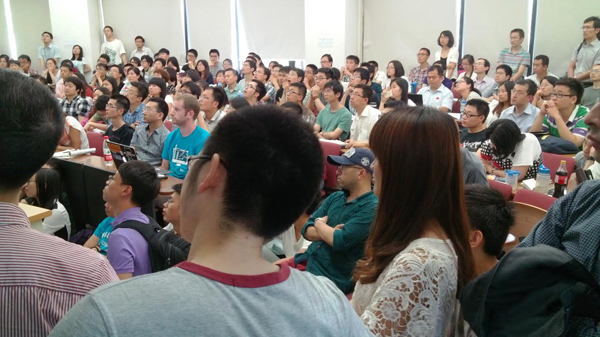A Folk Festival: The 7th China R Conference (May 24-25, Beijing)
Xizhi Wu, Professor of statistics, Renmin University of China, reports on the latest conference in a series he has helped to organize:
More than 1800 enthusiastic participants (including those unregistered) of various data-related disciplines, from more than 600 organizations with about 200 universities or institutes and 400 companies, rushed to overcrowded rooms of The 7th China R Conference, organized by students, graduates and COS, the student-run website Capital of Statistics, to listen to speakers on different topics. The speakers ranged from university professors, IT engineers to students. It was a big party. “I was really invigorated by the enthusiasm of the many R users at the conference,” said keynote speaker David Smith of Revolution Analytics on his website1.
Six years ago, The 1st China R Conference, initiated and organized entirely by a group of students and the student-run website COS, was held in a classroom of 100 seats with packed audience motivated by desire for promoting data analysis via the programming language R. Nowadays the R conference is not confined only to the R language. It propagates data analysis with all kinds of programming languages, including those for big data, and their combinations.
With the aim of promoting data-driven statistics application, the annual China R Conference is, if not the only one, an irreplaceable supplement to numerous mainly model-driven statistics conferences in China, and it also provides a meaningful and practical platform for communication between industry and academia. In developed countries programming languages, especially R, are widely used in universities and research institutes, whereas in China the classroom of statistics is mainly occupied by illegally pirated commercial software without any risk. The R Conference therefore is also a significant attempt to reduce the dependence of Chinese statisticians on pirated commercial software. Now, more and more Chinese students and teachers of statistics are using R for research and application; more and more statistics books published in China are using R. This was unthinkable six years ago.
Half of the participants in this seventh conference were under 26, while two thirds were under 29, and this age distribution implies a hopeful and promising future for Chinese statistics. No doubt, we either compute or we concede, as mentioned by Prof. Bin Yu, the president of IMS.
(David Smith put the Conference on his website with a photo. This conference is also on other websites such as SupStat and Chinese COS website.)
Editor’s note: We would like to recognize the instrumental contribution of Professor Wu to this conference series.

Such was the enthusiasm that participants sat on the floor, leaned against the walls, listened at the doors…
Comments on “Meeting Report: The 7th China R Conference”